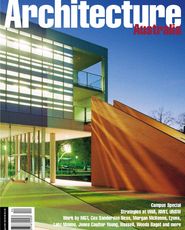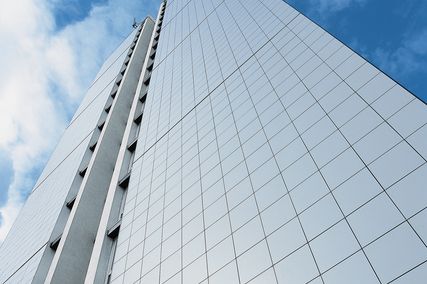It is now unprecedented how “signature” architects have become synonymous with museums and galleries, as institutions fight amongst themselves for cultural supremacy, funding and publicity. To celebrate the popular and critical success which Frank Gehry has brought to the Guggenheim franchise through its Bilbao Museum, the original Guggenheim, on 89th Street in New York by Frank Lloyd Wright, has its spiralling floors filled from top to bottom with Gehry’s work. Animated videos, huge, rough office models, clips of working drawings and notebooks, computer renderings and more attract a huge crowd of mainly non-American visitors, looking at a sculptural cacophony of architecture, far removed from the usual rationalities of commercial design. Illuminated “fish” objects, chain wire curtains, and cardboard furniture were all there to be seen and to be sat on.
In stark contrast, the much reduced Museum of Modern Art (MOMA), partially closed as it undergoes a major extension and refit by the minimalist Japanese architect Yoshio Taniguchi, prepares for a counter-exhibition on the work of Mies van der Rohe in Berlin. The Whitney Museum of American Art, yet to be successfully extended by a name architect, will simultaneously show an exhibition of Mies’s work in America. So for a few months over summer, both minimalism and maximalism will fight it out, while the three museums contemplate their next architectural project and its cultural implications.
Daniel Libeskind, in a spirited and powerful presentation to a full house in a Colorado convention centre, where he has just won the competition for a new wing next to Gio Ponti’s neo-medieval Denver Art Museum, reminded the audience that his Jewish Museum in Berlin – yet to have a single element of the collection installed – had already drawn 290,000 visitors since completion. Installation of the collection has just commenced, but the building’s success as an empty shell has caused curators to pause and be just a little nervous about fitting it out. Back in Denver, the city’s chief planner hugged and kissed the architect on stage, during rapturous applause, while the city’s museum director sat front row, beaming and barely containing his delight.
Almost a year after opening, the new Tate Modern at Bankside, the $A240m refit of Sir Giles Gilbert Scott’s “almost redundant from day one” power station by Swiss architects Herzog and de Meuron, has escalated the firm’s competition-entering stocks and the Tate’s contemporary design profile. The Tate reciprocates by amply promoting the architects and their work through books, magazines, T-shirts and hung samples of their work – perhaps a little pleased that there was sufficient controversy to generate interest, but not enough to derail or delay the project. And projected annual visitations of two million were eclipsed in two months.
Even Sauerbruch and Hutton, Berlin-based architects recently selected for the Museum of Contemporary Art in Sydney, have mouse mats featuring their GSW building in Berlin available over the counter. Given the recent success of Denton Corker Marshall in winning the competition for a visitors centre at the tourist shrine of Stonehenge in the UK, we can confidently imagine their circular pillars of Stonehenge bookmark with the little yellow pin at an angle.
What all this positivism means for architects is a little uncertain. If Gehry’s recently completed Deutscher Bank building in Berlin, which really wants to be a museum, can be taken as the extreme example, the design investment in buildings is beginning to echo the grand building achievements of the 1800s. At stake is a growing sense of pride of place and reflection of local cultures in a global continuum that is being embedded into the very fabric of cities. Despite this adulation and publicity, particularly in the US, architects continue to work long hours in their studios, building models, fighting deadlines, and entering into new marriages with ambitious clients. And while the outcome may cause initial conflict, the public gets another icon to grasp and hang their knowledge of a city on.
The museum visitors’ book at the little display of Libeskind’s proposal in Denver could be anywhere in the world. It had both positive and negative scribbled comments like “outrageous imposition”, “ignoring the context and out of scale”, and “looks like a crushed paper lamp”. Regardless, it will bring 500,000 visitors a year, guaranteed.















